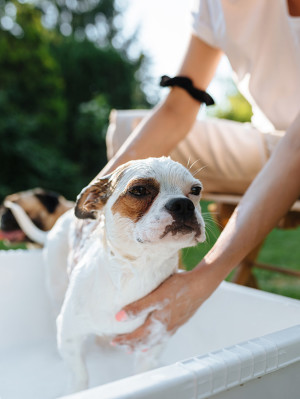Can I Put Vaseline on My Dog? Expert Insights on Proper Use
And alternatives you can use instead.
In This Article:
Is Vaseline Safe for Dogs? How Is Vaseline Used on Dogs? Dog-Friendly Alternatives to Vaseline
As a dog parent, you may wonder if it’s OK to use Vaseline on your pup’s skin. While Vaseline may be beneficial in some specific situations, it’s not commonly used on dogs. Your veterinarian can help guide you as to whether this is the right choice.
Is Vaseline safe for dogs?
It’s normal to want to do something when your dog has an ouchie. Whether it’s for a nick or scrape from overdoing zoomies, an incision from a surgical procedure, or a dry, crusty area from allergies, pet parents often reach for products like Vaseline, thinking they’ll help speed healing. But is Vaseline safe for dogs?
Vaseline is a brand with many, many products available, but the classic jar of Vaseline that most people think of is 100 percent white petrolatum, also called petroleum jelly or soft paraffin. Vaseline has been recommended as a home remedy for many problems in the past, but its primary uses in people are to keep wounds moist and as a barrier to prevent moisture loss from tissues. Vaseline has not been extensively evaluated as a treatment for anything in dogs.
How much do you spend on your pet per year?
Vaseline is generally considered non-toxic to dogs, but it can potentially cause some issues. The most common problem is that it causes a very gross, very greasy diarrhea if ingested in significant quantities. Vaseline can also cause significant irritation in the unlikely case that it gets into a dog’s eyes.
Like other petroleum-based products, Vaseline has a risk of causing aspiration pneumonia if ingested. Oily substances are prone to sliding down a dog’s trachea into the lungs and causing irritation, resulting in pneumonia. The risk of this complication is lower with Vaseline than it is with less viscous products like motor oil or gasoline. But inducing vomiting is generally not recommended if a dog eats Vaseline due to the risk of aspiration.
Is Vaseline cocoa butter safe for dogs?
Vaseline makes many products with cocoa butter in them. There is a formulation of their classic petroleum jelly with added cocoa butter and fragrances. Despite coming from the same plant, cocoa butter does not contain any of the same toxic substances that cause dogs to get sick from eating chocolateopens in new tab. Cocoa butter can lead to the same issues of stomach upset and aspiration as petroleum jelly.
What happens if your dog licks Vaseline?
If your dog licks off a little Vaseline that you put on a wound or dry spot, it’s unlikely to cause a problem. There’s not an exact amount of petroleum jelly that will trigger diarrhea in a dog, but licking off a thin layer of Vaseline is not expected to result in liquid-y poops. Problems usually start when a dog goes to town on a jar or tube of Vaseline.
How is Vaseline used on dogs?
Vaseline does not have any well-studied, approved uses on dogs. Your veterinarian may recommend using Vaseline or a similar product in a few specific situations where its effects are helpful, but it isn’t used routinely in veterinary care. A few common questions about using Vaseline include:
Can I put Vaseline on my dog’s paw pads?
One possible use for Vaseline is to help heal dry, cracked paw pads. Petroleum jelly products may help to soften paws and provide a barrier to moisture loss. If you use Vaseline on your dog’s paws, be sure to watch out for slick spots on your floors — your dog will spread it everywhere they go. Some pups also love licking their paw pads, so it’s unlikely to stick around for long if your dog is a licke r.
Some pet parents feel that applying Vaseline to their dog’s paws before going on a walk in a rocky or icy area helps to protect them, while others think that the slick barrier may cause problems with grip. Booties are likely a better solution overall but do take a little time for dogs to get acclimated.
Can I put Vaseline on my dog’s wound?
Routine use of products like Vaseline for dog wounds is not needed. Even antibiotic ointmentsopens in new tab with a similar petrolatum base aren’t generally recommended for dogs. Putting Vaseline on a wound increases the chances that your dog will lick the area, possibly introducing bacteria from their mouth and causing increased contamination.
Vaseline may sometimes be recommended by your veterinarian to prevent scab formation in a large, open wound that has reached a certain point in healing. Large wounds can be complex to manage and require different coverings as they progress through the stages of healing, so this use is only recommended under your vet’s guidance. Dogs with wounds of this type also usually wear Elizabethan collars (cones) to prevent them from licking at the area as it heals, so ingestion and contamination are less of a concern.
Can I put Vaseline on my dog’s nose?
If your dog has a condition that results in a cracked, dry nose, topical ointments may help with healing. Petrolatum products like Vaseline may be recommended to help prevent tissues from drying out and forming scabs. The problem is that dogs love licking things off their noses, and it’s impossible to prevent them from removing anything you apply.
Can I remove a tick on my dog with Vaseline?
Vaseline is not effective at removing ticks. Slathering it on a live tick attached to a dog does nothing, and putting Vaseline on a tick bite after the tick is removed does not help anything either. There are much better tick removal options out there.
Can I moisturize my dog’s skin with Vaseline?
Vaseline is not ideal for moisturizing a dog’s skin. It would take a lot of Vaseline to cover a dog, increasing the risk of a diarrhea explosion if they lick it off. It also tends to stick to everything, meaning that your dog is going to bring back a lot of debris from outside. Who wants a greasy, grimy pup leaving slick spots all over their floors and furniture?
Dog-friendly alternatives to Vaseline
If your dog is having problems with a dry, flaky coat or cracked paw pads, there are numerous products made for dogs to help with this. Home remedies may make you feel like you’re doing something, but often don’t address the root of the problem. If you’re thinking about using Vaseline for your dog, you can try these other options instead:
Veterinary products
Seeing your vet is the best plan if your dog is having any skin issues. They can help determine if the problem stems from an allergy, autoimmune disease, parasite, or other issue. Once your vet finds the cause of the skin irritation, they can recommend specific topical ointments, shampoos, or medications to help keep your dog’s skin healthy.
Coconut oil
Just like Vaseline, coconut oil is often recommended as a panacea for skin problems. It’s theorized that the fats in coconut oil may help with allergies and other skin issuesopens in new tab, but the evidence for this isn’t strong. While it’s safe for dogs to ingest in small amounts, it can cause pancreatitis, vomiting, or diarrhea due to its fat content.
Commercial dog-specific balms
There are numerous products for any chapped area on a dog’s skin, especially the paw padsopens in new tab, nose, and nipples (for nursing moms). Talk to your veterinarian about which products they have seen work well for dogs. Always start with a small test of any new product to make sure they don’t have a reaction to it before you spread it over a wide area.
FAQs (People also ask):
Can I put Vaseline on my dog’s paws?
Products containing petroleum jelly (like Vaseline) may help dry, cracked pawsopens in new tab soften and heal, though this hasn’t been proven. If used, dogs should be monitored for signs of vomiting or diarrhea in case they lick it off.
Can you put Vaseline on dog scabs?
Use of Vaseline on a dog’s scabs is unlikely to help anything and may cause licking that could introduce bacteria to a wound. It’s best to get any wounds checked out by a veterinarian for advice on healingopens in new tab.
Is it safe for dogs to eat Vaseline?
Dogs should not be encouraged or allowed to eat Vaseline. While licking a small amount of petroleum jelly is unlikely to cause issues, eating Vaseline can result in aspiration pneumonia or diarrhea.












